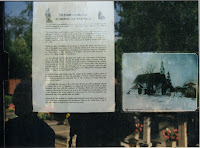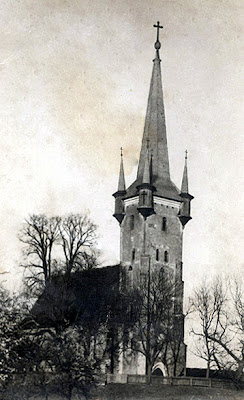The Szatkowski Family
Another line of our Polish family came to America about ten years before Stephan Baranowski. Tomasz Szatkowski and his family lived in Radzewo, Poznan, Poland. It is a small village near Srem on the map. He came to the US first on 23 October 1872, sailing from Hamburg to New York aboard the ship HOLSATIA. He may have lived in Chicago for a while. Apparently he went back to Poland for a while. He returned again to the US, alone, aboard the ship LESSING and arrived in New York on 25 June 1879.
He may have left his family back in Poland because his wife, Katarzyna, was pregnant. Tomasz was present in Calumet and was counted there in the 1880 census, living in a boarding house run by the Schmidt family. Katarzyna and her six children came later aboard the LESSING nearly a year later and arrived in New York on 26 May 1880 from Hamburg.
The children accompanying her were: Thomas; Marianna [b: Abt. November 1865]; Apolonia [b: August 10, 1866]; Franz (Francis) [b: Abt. August 1870] ; John Szatkowski [b: May 1877]; Wiktorya (Victoria) [b: September 14, 1879]; and Agnes (II) [b: May 08, 1879]. They joined Tomasz in Calumet.
Sometime during the next few years, Apolonia [or 'Polina' as she was known to most] met Stephan. They were married 29 September 1883 in Calumet. Over the next 23 years, they had the following children: John [b: October 1883], Ignatz [aka Nicholas] [b: January 1885], Lillian [b: November 1888], Francis Thomas [b: August 31, 1890], Stephen [b: December
1891], Stanislaus [b: October 01, 1892, who died young; Mariana [b: 1893], Theresa [b: May 1895], Hattie [b: September 1897], Leo John [b: January 22, 1899], Frances [b: 1901], (baby) Baranowski [b: July 19, 1904, who died at birth or shortly thereafter], Thomas [b: August 06, 1905, who also died shortly after birth], and Clara Baranowski [b: 1906].
For a a time, the family had a 'fifteenth' child. The story is that some of the boys, when walking home from school along the railroad tracks, found a newborn baby girl who had been abandoned. They took her home where the family took care of her for a couple of weeks until the county came and took her away to the orphanage.
Someone who knew the family from the 'old neighborhood' said that they were very musical. The boys hired out to work as caddies at the nearby golfcourse. Polina had a beautiful garden and orchard, and was fond of raising geese. She also had deep auburn hair.
Thomas and Catherine Szatkowski probably lived at 3029 Ridge St. from the time they arrived in Swedetown. In 1885, Thomas was badly hurt in a fall from a mine skip. It became debilitated and it was a contributing factor to his death of consumption three years later on 12 April 1888 according to C&H records. He is buried in the Hecla Cemetery in Laurium, Michigan. Catherine died of "hydropsis" [dropsy] in Calumet on 12 December 1908, and she is buried in Lakeview Cemetery outside of Calumet.
On 13 September 1887, Stephan's mother Mariana and his younger brother Wojceich arrived in New York from Bremen, Germany aboard the EIDER. It is here on her passenger list entry that the village of "Kotlin" is noted, possibly their last place of residence. Kotlin [pron. "koht-LEEN"] is located between the towns of Jarocin and Pleszewo, about 60 miles SE of the city of Poznan on the map. Kotlin is located on the Warta River, that same river which runs through Poznan.
On the passenger list entry, Mariana listed her age as 49 although she was really closer to 60. Wojciech lists his actual age of 17. 'George', as Wojciech became known in the US, met and married Apolonia's younger sister, Agnes. Their children were all born in Calumet and came to consist of: Mary; Theresa [b: 1897] ; Frances [bc:. 1902]; Joseph [bc: 1903]; Florence Ann [b: November 1929]; John A. [b: 1906]; Alexander [b: c. 1909]; Eleanor [b: August 15, 1911]; and Agnes [b: December 03, 1914].
Many of the Baranowskis and Szatkowskis settled in an area Calumet called 'Swedetown'. At one time it consisted of over 100 homes, mostly log built. Stephan and Polina lived at 3016 Osceola.
In the local Polk Directory for Calumet, year 1895-96, Mariana is listed as "Barnosky, Mary [wid Laurence] . . ." She lived with Stephan and Polina from the time of her arrival until her death by liver cancer at age 96 on 16 February 1921. George and Agnes lived at 3027 Bridge St. Polina's sister Victoria and her husband Frank Zawada lived at 3030 Bridge St. Other related Polish families of those who lived in Swedetown included the Bomblinskis, the Ruzmiareks, the Koviaks, the Kruszkas, the Zawadas, the Maciejewskis, and its a good chance that the Dlubalas were related to the Szatkowskis.
Polish names are often difficult for English speakers. Many official recorders often guessed at their spellings. Only in recent years has there been an attempt to be standardized. Baranowski has been written as Barnosky, Barinowski, Baranski, Borowski, Boronowski, and similar variations. The Szatkowski name has been spelled many different ways on records. Among them, Szadkowski, Shotkosky, Shokosky, Chicoski, Shoskish, and even McCasky.
Stephan and Polina's eldest son, John, changed his name after he moved 'out West' to 'Bliner". The family story is that he was in a bar fight in Chicago and he thought he killed his opponent. He left for Canada where he married. Eventually he came back to the US and settled in Washington. Only later did he find out that the man did not die of his injuries.
During the 1920s, Stephan, Polina, and several of their children moved to the Chicago area. Stephan lived at 3657 N. Ridgeway Ave. at the time of his death of bacterial myocarditis, asthma, and exhaustion on 28 May 1928. Afterwards, Polina lived with her daughters. When she died on 16 December 1938, she lived at 4190 Elston Ave. Her death was a result of myocarditis, artheriosclerosis, and anemia. They are buried in the Lakeview Cemetery near Calumet, Michigan.
 The history of the church of St. Michael the Archangel was transcribed from a document photographed at the church in April, 2000.
The history of the church of St. Michael the Archangel was transcribed from a document photographed at the church in April, 2000.










